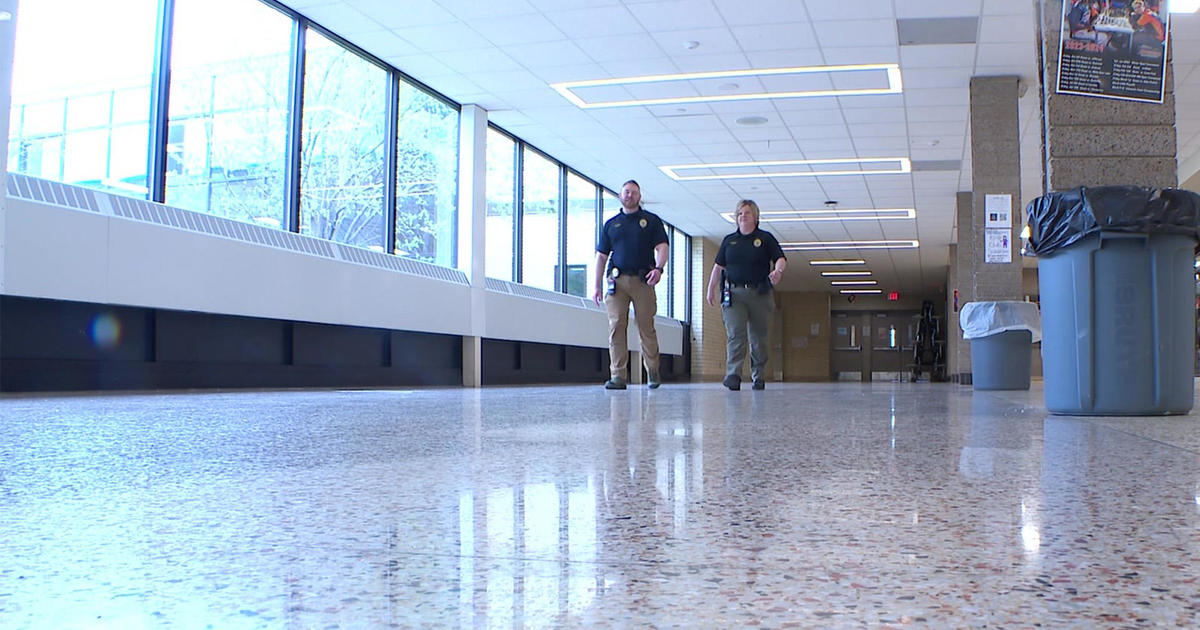Artist Leaves His Footprint On The World
WINONA, Minn. (WCCO) -- A Minnesota artist's greatest tool just may be his determination. When Ron Gramling, age 42, of Winona, Minn. lost the use of his hands, he turned his disability into possibility.
"This is something new that I have learned about him, recently," said Peggy Reps of Lewiston, one of Gramling's painting students.
Reps and a small group of women meet in the basement of St. Paul's Lutheran Church in Lewiston every week to paint. Most of them had never picked up a paint brush until they met Gramling.
In a few years, Gramling taught his painting class to craft stunning scenes, all while hiding what he once considered an artist's most shameful secret.
He instructs only by voice, never picking up a paintbrush himself.
"I don't know that I would have had the strength that he has shown," said student and friend Dianne Rislow.
In downtown Winona, Gramling's art gallery is filled with Minnesota landscapes and mystical places -- his life's work. Those frames now hold the past, because he will never paint like that again.
Today, his only tools are a tower of white socks and his right toe.
"I was going through socks at a very fast pace," said Gramling. "I'm a foot painter ... It took about five years to say that. It's a fairly odd thing to tell people you are painting with your feet. I was embarrassed by it."
Five years ago, is when the piercing pain began. Gramling was a graphic artist by day and painter by night.
"It's the same, exact motion of how this injure happened, which is doing a computer job and I'd go home and do that same thing with a paintbrush," said Gramling.
He spent his days using a digital pen to correct photographs and hours more using the same hand to hold his paintbrush.
A doctor's diagnosis crippled his career: cumulative trauma disorder -- for Gramling it was near-paralysis from overusing his hands. Surgery and medications failed. He says he can find no cure.
Dr. Jennine Speier with the Sister Kenny Rehab Institute at Abbott Northwestern Hospital says she has seen an explosion of patients with Gramling's condition, mostly due to technology-related jobs.
She says cumulative trauma disorder happens with prolonged repetitive muscle use, along with awkward movement and force. At her practice, she says the condition is common with graphic designers, musicians, people in the recording industry and, in general, people who type or use a mouse all day long.
Speier says cumulative trauma disorder can be prevented by taking frequent breaks and using ergonomic tools, but once the damage is done, it can be very difficult to reverse. Intense rehabilitation is necessary to repair small muscles with microscopic injuries.
That's the case for Gramling.
"I lose all feeling from the shoulder down. Right now, there's hardly any feeling from here to here," said Gramling, pointing from his shoulder to his wrist. "So the hardest thing for me is, I look normal to people."
That conflict, appearing normal with excruciating pain, was the beginning of deep depression.
"I went absolutely crazy because how do you do art, when you can't do art?" said Gramling. "It's so frustrating to not be able to do what you are put on this earth to do, and that's be an artist for me. It's in every cell of my body. I have to paint."
Art did imitate life when Gramling picked up his camera. He recorded every painful moment, 70 hours over five years, all, he says, to prove he had no choice but to paint with his feet.
Gramling first put a paintbrush between his toes and found no hope when he tried to paint sitting down.
"I'd got these knots in here," said Gramling, pointing to his toes. "So for an entire year, I could not paint."
Frustrated, Gramling became a recluse.
An artist can wait his entire life for a breakthrough, and finally, Gramling's came by accident, when one day he dragged his toe across his canvas.
"Then it's thousands and thousands and thousands of those toe prints, built up in layers like that," said Gramling.
It's a deliberate ballet of tapping, twisting and balancing, a process that can take several months before a painting is revealed.
He says using a different part of his body opened up a different part of his mind.
"When this happened to me, I thought it was the worst thing in the entire world. After about three years, I realized it was the best thing that ever happened to me in the entire world," said Gramling. "I always wanted to break new ground as an artist. I just didn't know how until I was literally forced into doing that."
It took around three years and 32 paintings before Gramling realized he had landed back on his feet. His former landscape paintings were realistic with muted colors. His new view of nature became bold and abstract.
"Because I thought if I'm bizarre enough to be painting with my feet and telling people that, I might as well use the colors that I am truly feeling inside, you know?" said Gramling.
On every painting is his size 12 signature -- a blue footprint -- marks a final step forward.
"I was hoping that through that I could inspire one person out there," said Gramling. "Something clicked inside my mind and I started to see the world in a completely different way."
Today at his painting class, Gramling's students now capture the beauty of what can be imagined and what can be overcome.
"There's many more things that we can do just by watching his example," said Rislow, who credits him as an inspiration.
Gramling has now overcome his challenge in another way. He launched a public art project called Artovance, on the premise that even if he couldn't physically create art, someone else could do it for him.
"It ended up being my ultimate dream project -- to let everybody else do art. I envisioned this book being passed from person to person, and thought 'Wow, what if someone would feed out of that person's idea?'" said Gramling.
In these books, people create a page of their own art in a book and pass it along to someone else. So far, it's reached across to hundreds of schools and hospitals in the U.S. and is being used as art therapy. The books are even in 20 countries around the world, according to Gramling.
His journey is proof that it doesn't matter what hand life has dealt Ron Gramling, he's an artist who has already left his footprint on the world.



